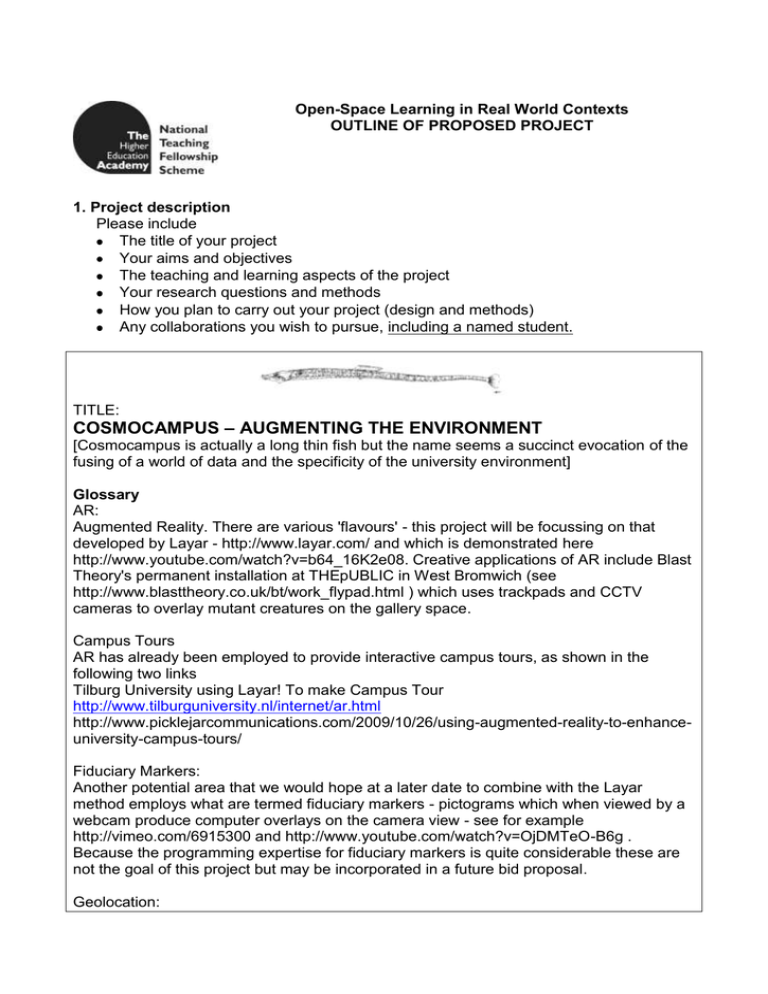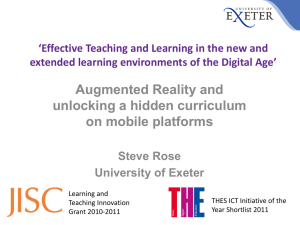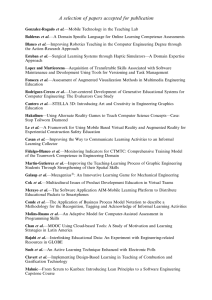Open-Space Learning in Real World Contexts OUTLINE OF PROPOSED PROJECT
advertisement

Open-Space Learning in Real World Contexts OUTLINE OF PROPOSED PROJECT 1. Project description Please include The title of your project Your aims and objectives The teaching and learning aspects of the project Your research questions and methods How you plan to carry out your project (design and methods) Any collaborations you wish to pursue, including a named student. TITLE: COSMOCAMPUS – AUGMENTING THE ENVIRONMENT [Cosmocampus is actually a long thin fish but the name seems a succinct evocation of the fusing of a world of data and the specificity of the university environment] Glossary AR: Augmented Reality. There are various 'flavours' - this project will be focussing on that developed by Layar - http://www.layar.com/ and which is demonstrated here http://www.youtube.com/watch?v=b64_16K2e08. Creative applications of AR include Blast Theory's permanent installation at THEpUBLIC in West Bromwich (see http://www.blasttheory.co.uk/bt/work_flypad.html ) which uses trackpads and CCTV cameras to overlay mutant creatures on the gallery space. Campus Tours AR has already been employed to provide interactive campus tours, as shown in the following two links Tilburg University using Layar! To make Campus Tour http://www.tilburguniversity.nl/internet/ar.html http://www.picklejarcommunications.com/2009/10/26/using-augmented-reality-to-enhanceuniversity-campus-tours/ Fiduciary Markers: Another potential area that we would hope at a later date to combine with the Layar method employs what are termed fiduciary markers - pictograms which when viewed by a webcam produce computer overlays on the camera view - see for example http://vimeo.com/6915300 and http://www.youtube.com/watch?v=OjDMTeO-B6g . Because the programming expertise for fiduciary markers is quite considerable these are not the goal of this project but may be incorporated in a future bid proposal. Geolocation: Linking data to geographic locations Selective Bibligraphy R Azuma, Y Baillot, R Behringer, S Feiner, S Julier, and B MacIntyre, 'Recent Advances in Augmented Reality', Ieee Comput Graph, 21 (2001), 34-47. Christoph Bichlmeier, Sandro Michael Heining, Marco Feuerstein, and Nassir Navab, 'The Virtual Mirror: A New Interaction Paradigm for Augmented Reality Environments', Ieee T Med Imaging, 28 (2009), 1498-510. M Billinghurst, R Grasset, and J Looser, 'Designing Augmented Reality Interfaces', Comput Graphics-Us, 39 (2005), 17-22. M Billinghurst, and H Kato, 'Collaborative Augmented Reality', Commun Acm, 45 (2002), 64-70. GC Burdea, MC Lin, W Ribarsky, and B Watson, 'Guest Editorial: Special Issue on Haptics, Virtual, and Augmented Reality', Ieee T Vis Comput Gr, 11 (2005), 611-13. Scott deLahunta, 'Virtual Reality and Performance', PAJ: A Journal of Performance and Art, 24 (2002), 10514. Maria R Ebling, and Ramon Caceres, 'Gaming and Augmented Reality Come to Location-Based Services', Ieee Pervas Comput, 9 (2010), 5-6. S Feiner, B MacIntyre, and D SELIGMANN, 'Knowledge-Based Augmented Reality', Commun Acm, 36 (1993), 53-62. rd Rolf R. Hainich The End of Hardware: Augmented Reality and Beyond 3 Edition Booksurge Llc (2007) Gun A Lee, and Gerard J Kim, 'Immersive Authoring of Tangible Augmented Reality Content: A User Study', J Visual Lang Comput, 20 (2009), 61-79. Sang Hwa Lee, Junyeong Choi, and Jong-Il Park, 'Interactive E-Learning System Using Pattern Recognition and Augmented Reality', Ieee T Consum Electr, 55 (2009), 883-90. W Piekarski, and B Thomas, 'Arquake: The Outdoor Augmented Reality Gaming System', Commun Acm, 45 (2002), 36-38. Cristina Portales, Jose Luis Lerma, and Santiago Navarro, 'Augmented Reality and Photogrammetry: A Synergy to Visualize Physical and Virtual City Environments', Isprs J Photogramm, 65 (2010), 134-42. Kurt Squire, 'From Content to Context: Videogames as Designed Experience', Educational Researcher, 35 (2006), 19-29. Bruce H Thomas, and Christian Sandor, 'What Wearable Augmented Reality Can Do for You', Ieee Pervas Comput, 8 (2009), 8-11. Steven J Vaughan-Nichols, 'Augmented Reality: No Longer a Novelty?', Computer, 42 (2009), 19-22. V Vlahakis, N Ioannidis, J Karigiannis, M Tsotros, M Gounaris, D Stricker, T Gleue, P Daehne, and L Almeida, 'Archeoguide: An Augmented Reality Guide for Archaeological Sites', Ieee Comput Graph, 22 (2002), 52-60. Jason Wither, Stephen DiVerdi, and Tobias Hollerer, 'Annotation in Outdoor Augmented Reality', Comput Graph-Uk, 33 (2009), 679-89. AIMS AND OBJECTIVES: To provide a grounding in authoring for AR with a form-based front-end for adding Points of Information (POI) To produce a campus-based AR Layar (http://www.layar.com/) either constructed from narratives and data determined by the group or potentially working in tandem with the department's Writing for Performance module. To publish and publicise the Campus Layar for all university staff and students TEACHING AND LEARNING ASPECTS: To explore the boundaries and interrelationships between sense data and digital information To invite students to consider the possibilities of augmented reality To familiarise students with open source API's (Application Programme Interface) as a means to gain access to and interact with data To situate AR within a field that includes social (Facebook, Twitter) scripted (MMORPGs Massively Multiplayer Online Role Playing Games) and sandbox worlds (Second Life) RESEARCH QUESTIONS AND METHODS: How do you devise an experience for users rather than an audience? Iterating the authoring/testing process to determine desirable levels of information and degrees of interactivity What are the challenges of writing a site-specific but time-independent experience? Reflecting on how POIs change during the course of a day and over longer periods and considering ways in which the overlaid information can change and evolve to reflect these changes What areas of activity eg gaming, information delivery, performance scenarios are best suited to AR? The intention is to situate the authoring of Layars within the Aspects of Practice module Performing Online that I am running for the first time in 2010. A term-long module, Performing Online seeks to promote an understanding of the performative nature of online encounters and the possibilities inherent in hybrid forms that combine virtual and real worlds. The AR work will be considered alongside other online experiences and its relative merits and weaknesses discussed. DESIGN AND METHODS Students will be provided with Layar Developer keys (that enable them to author and publish layars) at the start of the course in October as part of a digital toolkit of software, articles, images, videos and other information germane to the module. Because the authoring experience is heavily reliant on navigating between the visual and the virtual, development time is not best suited to reading week when students may not be on campus, therefore it is proposed that practical instruction in authoring is provided in week 2 (of 10) and time set aside in each session for updates on progress leading up to publication of layars in Week 8, tweaking and enhancing in week 9 and notification to the University community in Week 10. COLLABORATIONS: The 2nd Year Performing Online module is being audited by a third year student, Luke Mason, who has a passion for digital work and is working with me for his final year dissertation entitled Coding Consciousness: Transhumanist Aesthetics in Performance. Luke is what some folks like to call 'digitally native' and is ideally suited to driving this project forward, both conceptually and technically. Luke is currently working with a computer coder at Warwick on a project based on the android phone that uses geolocation and sound files to create a sound map of campus and so there are obvious points of contact with his interests and that of the project. 2. Which aspect of Open-space Learning does the project address? (Please include all that apply and give details of how they will be addressed) Exploring innovative teaching and learning in and for the higher education community in England Applying workshop practice and collaborative learning in flexible teaching spaces Employing enactive and experiential learning, applied drama, role play and ethnodrama Identifying workable assessment methodologies for these styles of learning Testing the efficacy of OSL and measuring its impact • Exploring innovative teaching and learning in and for the higher education community in England Quite a number of investigations of the virtual have emmigrated online (as in the instance of Second Life experiments) and/or submitted to the look, feel and structure of fictive worlds (from World of Warcraft to Eve Online) whereas AR encourages the developer to augment (but perhaps, more productively, to challenge and reasses) the world as it is seen. The notion of immersion in AR is quite distinct from other practices because there is a direct correlation between where the user stands and looks and the information that they have access to. It is a rash claim to suggest that this is a redrawing of reality (and if I appear to have made it let me retract it now!) but it does provide a counter to the accumulated preconceptions we have of place by interposing a whole layer of contemporaneous information that might enhance, frustrate and manipulate the value we place on what is in front of us (conditioned, usually subconsciouslly, by what we already 'know' of that place). Students will be encouraged to author non-invasive alterations of place, to non-destructively re-write the environment and compose conversations between people, places and data. • Applying workshop practice and collaborative learning in flexible teaching spaces Working in groups of two, students will be encouraged to test and evaluate layars being developed by other groups, sharing best practice and providing feedback on the quality and value of the experience. Much of the work will be carried out around campus as the students identify correspondences between what is seen and what is conveyed or what happens (the system allows for audio and objects to be tagged to POIs) - many of the exisiting layars are information-led (campus tours such as those at http://site.layar.com/catalog/categories/schools-universities/) but the system also has the potential to generate narrative arcs that span the campus akin to the Tocil Woods Project (2007) developed by my colleague Susan Haedicke that led the audience around the scene of a violent incident in the woods on campus • Employing enactive and experiential learning, applied drama, role play and ethnodrama The experiential aspect of the AR environment is apparent but, as noted above, the construction of imaginary worlds (rather than the confirmation of what is in front of the user by means of information that supplements the visual) is still nascent rather than pervasive. The project would invite the Theatre Studies students to bring their devising and writing skills to the AR environment, possibly, as mentioned above, in conjunction with students from the Writing for Performance module • Identifying workable assessment methodologies for these styles of learning Within the interface it is possible to provide feedback (via sms, email or a web form) and usage can be determined either via the backend or elselogging hits to various webpages that are invoked by the proximity of the user to a specific POI. As the 2nd Year Aspects module has a pre-determined assessment pattern that precludes awarding marks for practical work, assessment in this instance will be indirect, through the setting of written assignments that invite the student to reflect on the challenges of authoring augmented worlds. The course is intended to pilot material that will form the basis of a year-long practical module in 2011/12 (that could not be introduced this coming academic year because I am taking study leave in the Spring Term. • Testing the efficacy of OSL and measuring its impact My dread of instigating a module on Performing Online is that it keeps students staring at screens, transforming them into the 'meat' of Gibson's dystopia. The appeal of developing a project based on Layar's API is that it is inherently mobile (you need to move to activate different POIs), low-cost (it is proposed that some of the funding be used to acquire two devices which can either be Iphone 3GS or Android phones) and gives students a creative tool that they can not only employ in future work but that they might subsequently employ for commercial gain. I believe there is scope to develop an informational AR Layar for the campus and the students working on this project would be ideally suited to develop such an application and it is anticipated that such activities would be proposed after the module has concluded. How does your project link with the aims and objectives of the OSL project? Broadly, this project takes the resistance to the "rigidly hierarchical space of lecture theatre and seminar room" and applies it to any space that imposes its expectations upon the person confronting it. The authoring students are encouraged to create embodied learning experiences for users, forcing them to reflect on how this might best be achieved and in a very real sense re-connecting mind, body and world. 3. Timescale Preferred start date: 25th August 2010 Estimated completion date: May 2011 What is your proposed schedule of work for this project? Please indicate the numbers of students involved and key dates. Schedule 25th August - 10th September Development of Digital toolkit including Layar resources and scripting of authoring tools and form-based scripting environment. 13th September - 17th September Contacting students on the course with toolkit, establishment of online tools and support (blog, forum, filestore etc) 14th October (Thursday) - session 2 - Augmented Reality - theoretical and practical exploration of AR and setting of project 21st October / 28th October / 4th November / 18th November Short section in class updating progress on AR development (supplemented by online support and sharing of work) 25th November Publication of work 2nd December Testing and Tweaking of published Layars 6th December Layars goes live for final week of term and beyond 9th December Ask students to submit feedback on the project 13th December Gather data on usage and feedback and compile report on the project to be concluded by 20th December [As Dr White will be on study leave from Jan to Mar 2011, the article from the project will be created in April/May 2011] Number of students on Performing Online module: 9 or 10 4. Impact What are the expected outputs and outcomes of your project? What are your success criteria? Outputs: 5 Layars available to anyone on campus 1 report on the project 1 article in RIDE or similar Success criteria Completion of project by students is the minimum expectation but it is hoped that interest and usage of the resulting work would be strong and that it led to students continuing to work in this area either in final year practical work or in a commercial setting. 5. Dissemination and evaluation How do you see the outputs disseminated within the University of Warwick and outside? The layars will only be consumable on Warwick campus. Their dissemination will be an issue to be discussed at the Week Two session - are the intended audience visitors or 'locals' (or both). Beyond the experience itself it is hoped that Luke and I would pull together the findings from the project into an article suitable for publication in Research in Drama Education (RIDE) or similar. How will you evaluate the success of your project? Use of the layars Enthusiasm amongst the students to continue developing work in this area Success of subsequent bids to develop more extensive AR project 6. Resources What are the resources you need to carry out your project? e.g. Travel, video/audio recording, fees, specialist equipment, clerical support… Name of Applicant (please print): Tim White Department/School: School of Theatre, Performance & Cultural Policy Studies Signature of Applicant: Date: 24/5/2010 Please submit this form by 12 noon 24 May 2010 to Dr Susan Brock, The CAPITAL Centre, Millburn House E: s.l.brock@warwick.ac.uk ; T: 024761 50067. H:\OSL/projects//outline of proposed project rev. May. 2010




